Superheated Steam Temperature Control Based on a Hybrid Active Disturbance Rejection Control
Abstract
1. Introduction
- Some advanced controllers should be designed based on the accurate mathematical model of SST. However, it is difficult to obtain the accurate mathematical description of SST for the reason that the characteristics of SST changes with the working conditions.
- Because of their complexities in computation, most of advanced strategies are unable to be implemented on the distributed control system (DCS) of a power plant.
- A hybrid ADRC is proposed in order to simplify the control structure of the conventional SST control system.
- The stability of the hybrid ADRC is analyzed theoretically. Moreover, the ability of disturbance rejection of the hybrid ADRC is discussed in this paper.
- The tuning procedure of the hybrid ADRC is summarized based on the influences of its parameters on control performance.
- The hybrid ADRC has been applied to a power plant simulator successfully. Its control performance is validated by the running data.
2. The SST System and Its Regular Control
2.1. SST Model Description
- An accurate mathematical model of SST is unavailable.
- High order dynamics of the 2nd superheater results in a slow response to the set point and disturbances.
- Various disturbances such as load demand, combustion air flow and main steam flow have significant adverse impacts on SST.
2.2. Regular Control Structure of SST
3. Hybrid Active Disturbance Rejection Control
3.1. Regular Design of ADRC
3.2. Hybrid ADRC Design for SST System
3.3. Analysis of Hybrid ADRC
3.3.1. Stability Analysis
3.3.2. Rejection of the Secondary Disturbance
4. Tuning Procedure and Numerical Simulation
4.1. Tuning Procedure of Hybrid ADRC
- b1 is negative because it represents the estimation of the critical gain of G1(s). The smaller |b1| means a slower tracking speed, weaker dynamic deviation caused by the secondary disturbance and worse performance of rejecting the primary disturbance. However, |b1| should not decrease infinitely for the reason that the control signal will oscillate significantly which may lead to irreversible damage to the actuator.
- The increases of β3 and ωo will improve the control performance of the closed-loop system. Moreover, it is obvious that the output has no obvious change when they are big enough.
- With the increase of ωc, the control effect of the hybrid ADRC will be enhanced. Besides, the larger ωc means a greater overshoot.
- b0 decides the positive-negative action of the hybrid ADRC. In terms of the SST system, b0 is negative for the reason that SST is able to be regarded as a negative process in general. Contrary to ωc, the smaller |b0| means stronger control effect of the hybrid ADRC. In addition, its decrease will augment the overshoot.
- First of all, b1 and b0 should be fixed. b1 is recommended to set in the range (−∞,] while b0 is suggested to set in the range (−∞,].
- Set a small ωc. Then augment β3 and ωo to proper values until the output has no obvious change. Note that β3 and ωo are unable to increase infinitely in case that the control signal will oscillate fiercely.
- Augment ωc to a proper value until the overshoot and the settling time satisfy the control requirements.
- When the control performance is satisfactory, the tuning procedure terminates. Otherwise, repeat steps (1)–(3) as mentioned.
- According to the stability analysis, values of β3 and ωo should be positive.
- The final values of b1 and b0 are far smaller than −K1/(n1T1) and b1K2/(n2T2), respectively. In addition, during the tuning procedure, b1 and b0 are recommended to be tuned as the integral multiple of −K1/(n1T1) and b1K2/(n2T2), respectively.
- The initial value of ωc is recommended to set in the range [0.01, 0.1].
- The bandwidth of ESO ωo is recommended to be tuned as 3–10ωc in order to let the output has no obvious change.
4.2. Numerical Simulation
- It provides faster action to reduce the disturbance in inner loop;
- It improves the response rate and control accuracy for large lag systems;
- It reduces the effect of parameter variations in inner loop.
5. Field Application of the Hybrid ADRC on a Power Plant Simulator
5.1. The Model Identification Based on Multi-Objective Optimization
5.2. Field Application on a 150 MW Unit Simulator
5.2.1. Parameters of Control Strategies
5.2.2. Preliminary Numerical Simulations
5.2.3. Experiments on the Power Plant Simulator
- Compared with the different cascade control strategies in [4], the proposed hybrid ADRC is able to reject the secondary disturbance more steadily.
- The multi-objective optimization tuning method proposed in [24] requires a large amount of calculation. However, the tuning procedure of the hybrid ADRC is summarized as a flow chart in Section 4.1 which is easy to understand and use for engineers.
6. Conclusions
- The application of the hybrid ADRC to supercritical units and ultra-supercritical units.
- The frequency domain analysis of the hybrid ADRC.
- The development of the auto-tuning toolbox of the hybrid ADRC.
Author Contributions
Funding
Acknowledgments
Conflicts of Interest
References
- Wu, Z.; Li, D.; Xue, Y.; Chen, Y. Gain scheduling design based on active disturbance rejection control for thermal power plant under full operating conditions. Energy 2019, 185, 744–762. [Google Scholar] [CrossRef]
- U.S. Energy Information Administration. International Energy Outlook 2013; U.S. Energy Information Administration: Washington, DC, USA, 2013.
- Liu, J.L.; Zeng, D.; Tian, L.; Gao, M. Control strategy for operating flexibility of coal-fired power plants in alternate electrical power systems. Proc. CSEE 2015, 35, 5385–5394. [Google Scholar]
- Wu, Z.; He, T.; Li, D.; Xue, Y.; Sun, L.; Sun, L.M. Superheated steam temperature control based on modified active disturbance rejection control. Control Eng. Pract. 2018, 83, 83–97. [Google Scholar] [CrossRef]
- Han, J. From PID to active disturbance rejection control. IEEE Trans. Ind. Electron. 2009, 56, 900–906. [Google Scholar] [CrossRef]
- Wu, X.; Shen, J.; Li, Y.G.; Lee, K.Y. Fuzzy modeling and predictive control of superheater steam temperature for power plant. ISA Trans. 2015, 56, 241–251. [Google Scholar] [CrossRef]
- Ma, L.Y.; Lee, K.Y. Neural network based superheater steam temperature control for a large-scale supercritical boiler unit. In Proceedings of the IEEE Power and Energy Society General Meeting, Detroit, MI, USA, 24–29 July 2011; pp. 1–8. [Google Scholar]
- Shome, A.; Ashok, S.D. Fuzzy logic approach for boiler temperature & water level control. Int. J. Sci. Eng. Res. 2012, 3, 1–6. [Google Scholar]
- Wu, Z.; Li, D.; Wang, L. Control of the superheated steam temperature: A comparison study between PID and fractional order PID controller. In Proceeding of the 35th Chinese Control Conference, Chengdu, China, 27–29 July 2016; pp. 10521–10526. [Google Scholar]
- Hou, Z.; Xiong, S. On model-free adaptive control and its stability anaylsis. IEEE Trans. Autom. Control 2019, 64, 4555–4569. [Google Scholar] [CrossRef]
- Roman, R.; Precup, R.; Bojan-Dragos, C.; Szedlak-Stinean, A. Combined model-free adaptive control with fuzzy component by virtual reference feedback tuning for tower crane systems. Procedia Comput. Sci. 2019, 162, 267–274. [Google Scholar] [CrossRef]
- Shi, G.; He, T.; Wu, Z.; Li, D. Research on cascade active disturbance rejection control of superheated steam temperature based on gain scheduling. In Proceedings of the 19th International Conference on Control, Automation and Systems, Jeju, Korea, 15–18 October 2019; pp. 1426–1431. [Google Scholar]
- Gao, Z. Scaling and bandwidth-parameterization based controller tuning. In Proceedings of the American Control Conference, Denver, CO, USA, 4–6 June 2003; pp. 4989–4996. [Google Scholar]
- Wu, Z.; Li, D.; Xue, Y.; Sun, L.M.; He, T.; Zheng, S. Modified active disturbance rejection control for fluidized bed combustor. ISA Trans. 2020, in press. [Google Scholar] [CrossRef]
- Zhang, J.; Feng, J.; Zhou, Y.; Fang, F.; Yue, H. Linear active disturbance rejection control of waste heat recovery systems with organic rankine cycles. Energies 2012, 5, 5111–5125. [Google Scholar] [CrossRef]
- Huang, C.; Li, D.; Xue, Y. Active disturbance rejection control for the ALSTOM gasifier benchmark problem. Control Eng. Pract. 2013, 21, 556–564. [Google Scholar] [CrossRef]
- Dong, Z.; Liu, M.; Jiang, D.; Huang, X.; Zhang, Y.; Zhang, Z. Automatic generation control of nuclear heating reactor power plants. Energies 2018, 11, 2782. [Google Scholar] [CrossRef]
- He, T.; Wu, Z.; Shi, R.; Li, D.; Sun, L.; Wang, L.; Zheng, S. Maximum sensitivity-constrained data-driven active disturbance rejection control with application to airflow control in power plant. Energies 2019, 12, 231. [Google Scholar] [CrossRef]
- Sun, L.; Jin, Y.; You, F. Active disturbance rejection temperature control of open-cathode proton exchange membrane fuel cell. Appl. Energy 2020, 261, 114381. [Google Scholar] [CrossRef]
- Xue, W.; Zhang, X.; Sun, L.; Fang, H. Extended state filter based disturbance and uncertainty mitigation for nonlinear uncertain systems with application to fuel cell temperature control. IEEE Trans. Ind. Electron. 2020. [Google Scholar] [CrossRef]
- Ramirez-Neria, M.; Gao, Z.; Sira-Ramirez, H.; Garrido-Moctezuma, R.; Luviano-Juarez, A. On the tracking of fast trajectories of a 3DOF torsional plant: A flatness based ADRC approach. Asian J. Control 2020. [Google Scholar] [CrossRef]
- Wu, C.; Song, K.; Li, S.; Xie, H. Impact of electrically assisted turbocharger on the intake oxygen concentration and its disturbance rejection control for a heavy-duty diesel engine. Energies 2019, 12, 3014. [Google Scholar] [CrossRef]
- Liang, G.; Li, W.; Li, Z. Control of superheated steam temperature in large-capacity generation units based on active disturbance rejection method and distributed control system. Control Eng. Practice 2013, 21, 268–285. [Google Scholar] [CrossRef]
- Sun, L.; Hua, Q.; Shen, J.; Xue, Y.; Li, D.; Lee, K.Y. Multi-objective optimization for advanced superheater steam temperature control in a 300 MW power plant. Appl. Energy 2017, 208, 592–606. [Google Scholar] [CrossRef]
- Xia, Y.; Liu, B.; Fu, M. Active disturbance rejection control for power plant with a single loop. Asian J. Control 2012, 14, 239–250. [Google Scholar] [CrossRef]
- Guo, B.Z.; Zhao, Z.L. On the convergence of an extended state observer for nonlinear systems with uncertainty. Syst. Control Lett. 2011, 60, 420–430. [Google Scholar] [CrossRef]
- Huang, Y.; Xue, W. Active disturbance rejection control: Methodology and theoretical analysis. ISA Trans. 2014, 53, 963–976. [Google Scholar] [CrossRef]
- Dorf, R.C.; Bishop, R.H. Modern Control System Eleventh Edition; Pearson Education, Inc.: Hoboken, NJ, USA, 2008. [Google Scholar]
- Wu, Z.; Zhang, F.; Shi, G.; He, T.; Li, D.; Chen, Y. Frequency-domain analysis of a modified active disturbance rejection control with application to superheated steam temperature control. In Proceedings of the 19th International Conference on Control, Automation and Systems, Jeju, Korea, 15–18 October 2019; pp. 44–50. [Google Scholar]
- Li, X.; Ding, D.; Wang, Y.; Huang, Z. Cascade IMC-PID control of superheated steam temperature based on closed-loop identification in the frequency domain. IFAC-PapersOnLine 2016, 49, 91–97. [Google Scholar] [CrossRef]
- Zhang, F.; Xue, Y.; Li, D.; Wu, Z.; He, T. On the flexible operation of supercritical circulating fluidized bed: Burning carbon based decentralized active disturbance rejection control. Energies 2019, 12, 1132. [Google Scholar] [CrossRef]
- Deb, K.; Agrawal, S.; Pratap, A.; Meyarivan, T. A fast elitist non-dominated sorting genetic algorithm for multi-objective optimization: NSGA-II. In Proceedings of the 6th International Conference on Parallel Problem Solving from Nature, Paris, France, 18–20 September; pp. 849–858.
- He, T.; Wu, Z.; Li, D.; Wang, J. A tuning method of active disturbance rejection control for a class of high-order processes. IEEE Trans. Ind. Electron. 2019, 67, 3191–3201. [Google Scholar] [CrossRef]
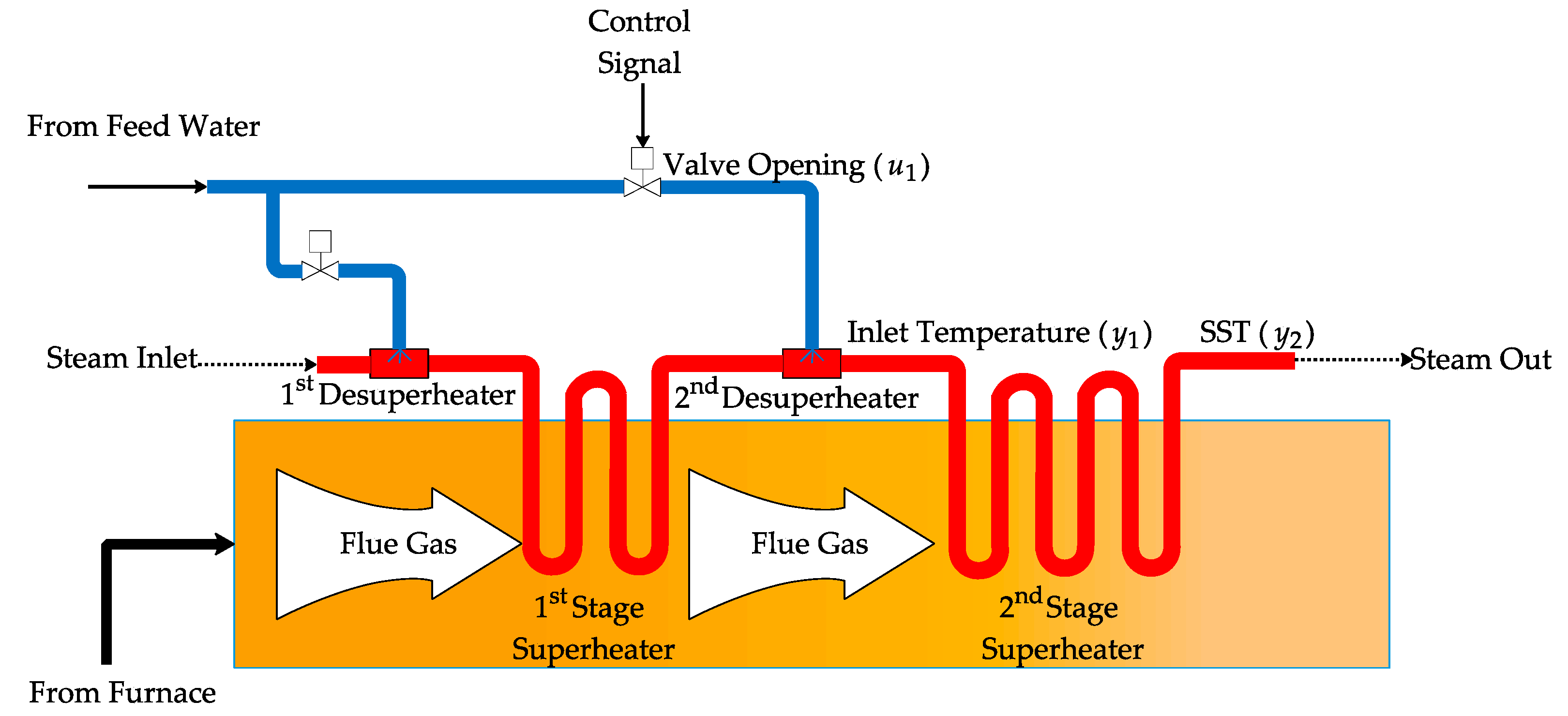





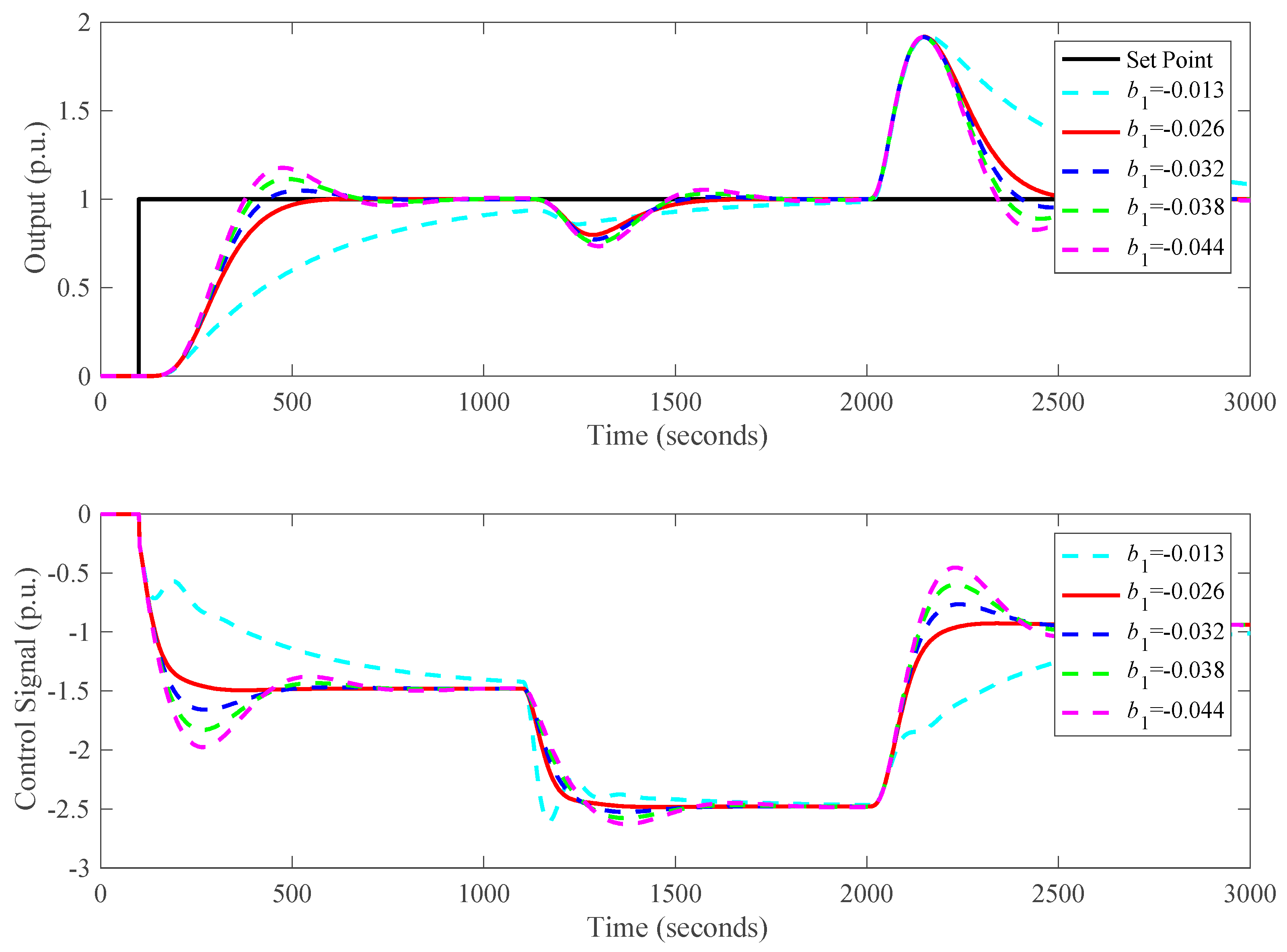
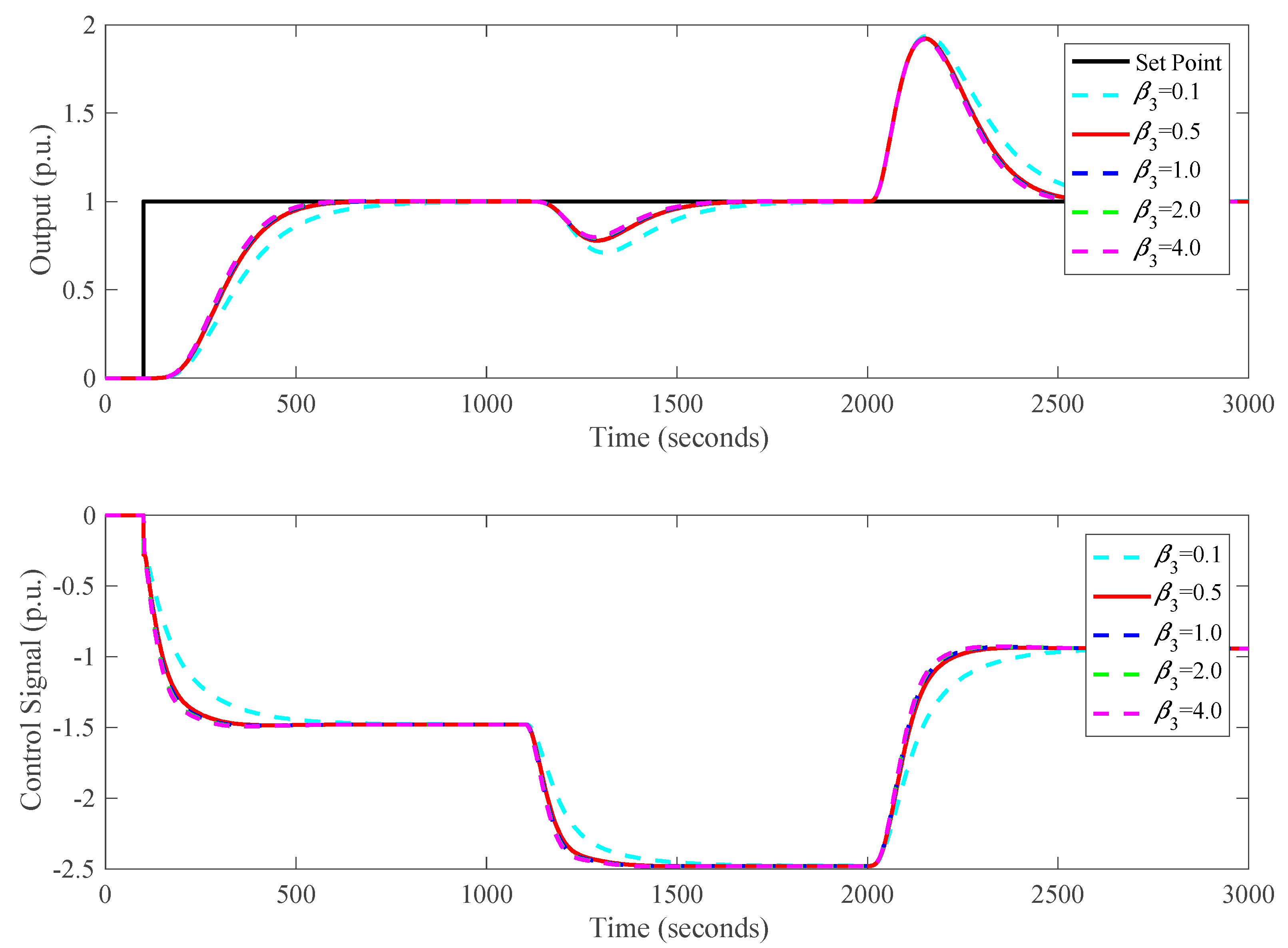
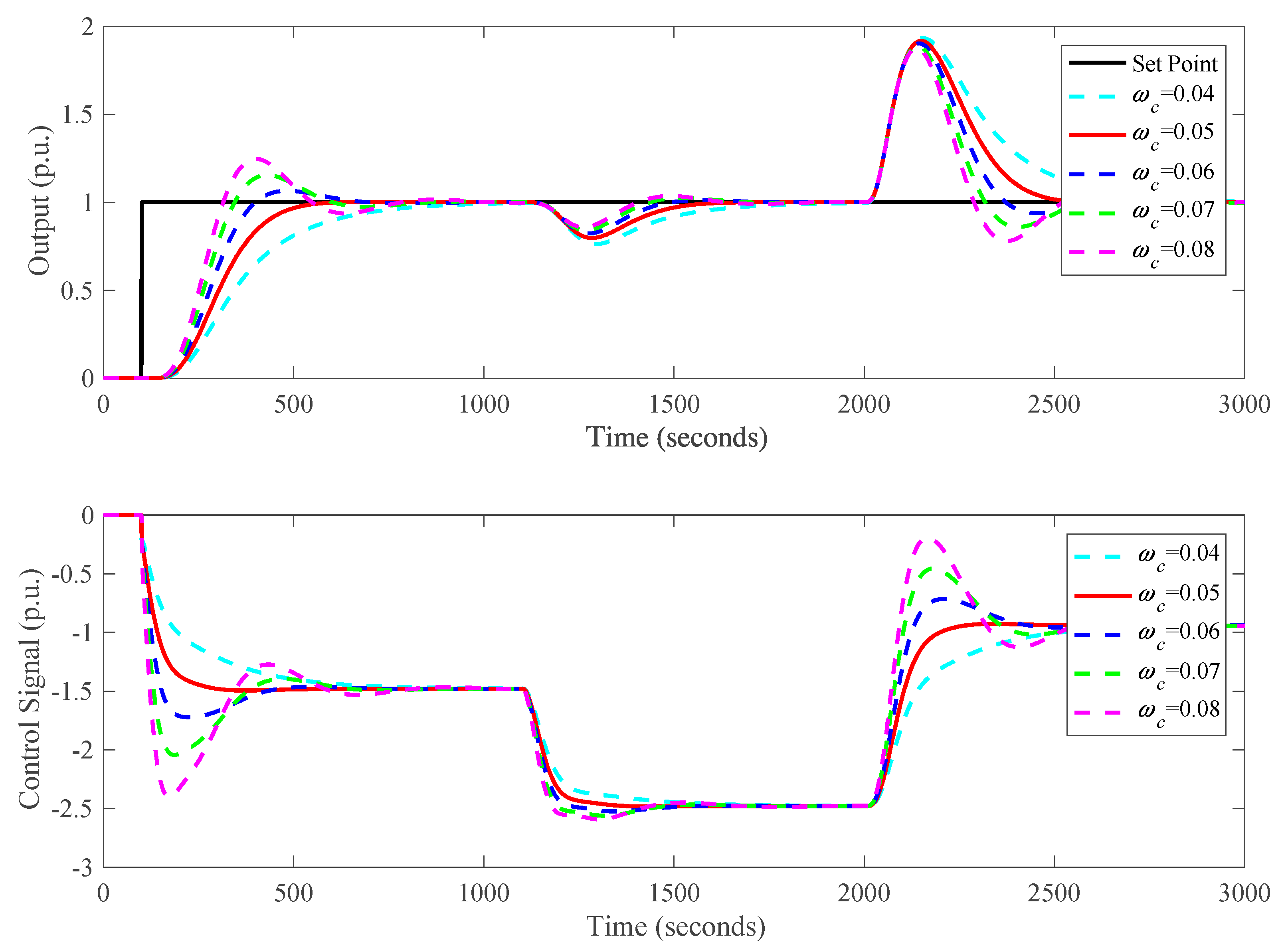
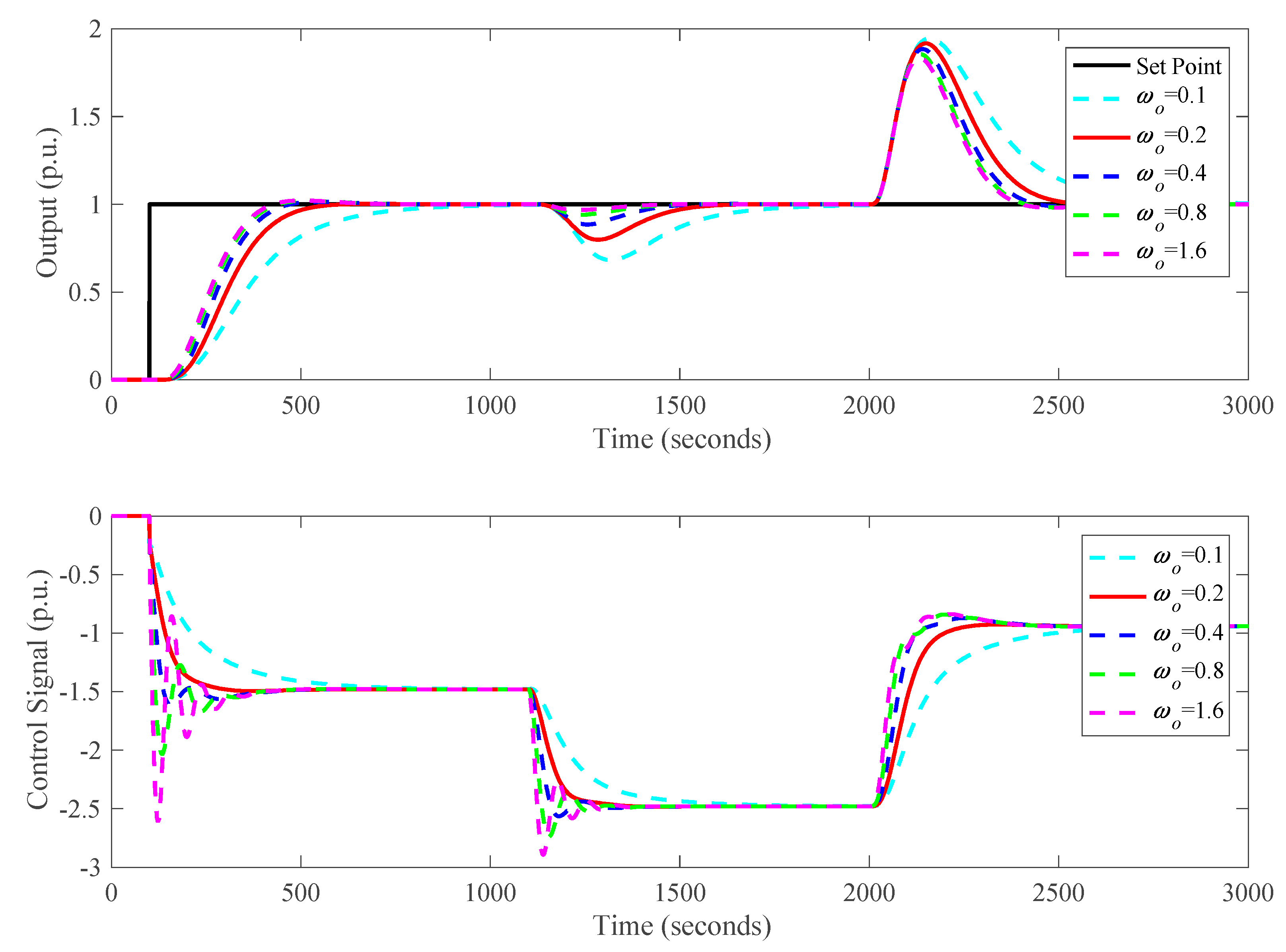
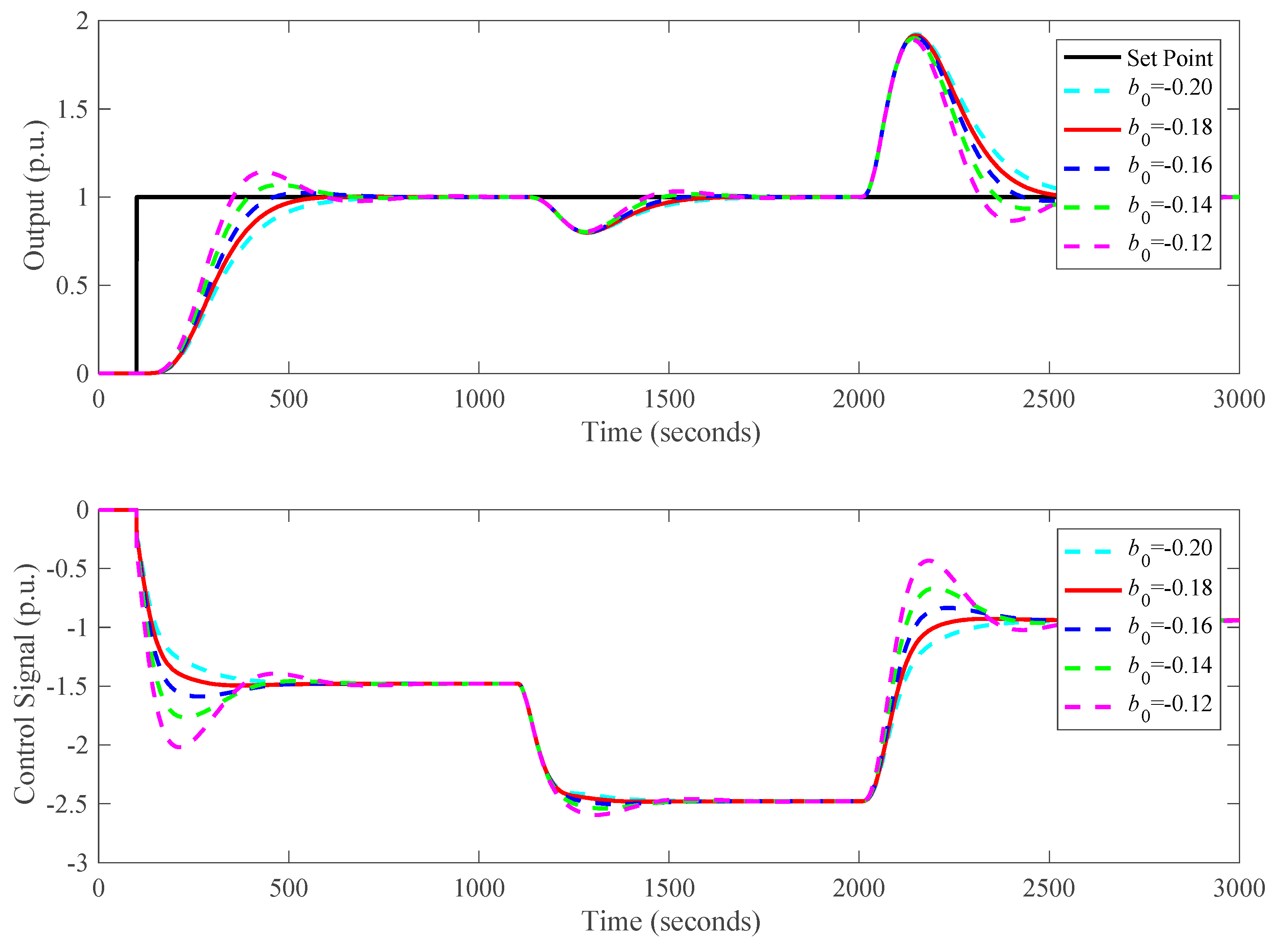
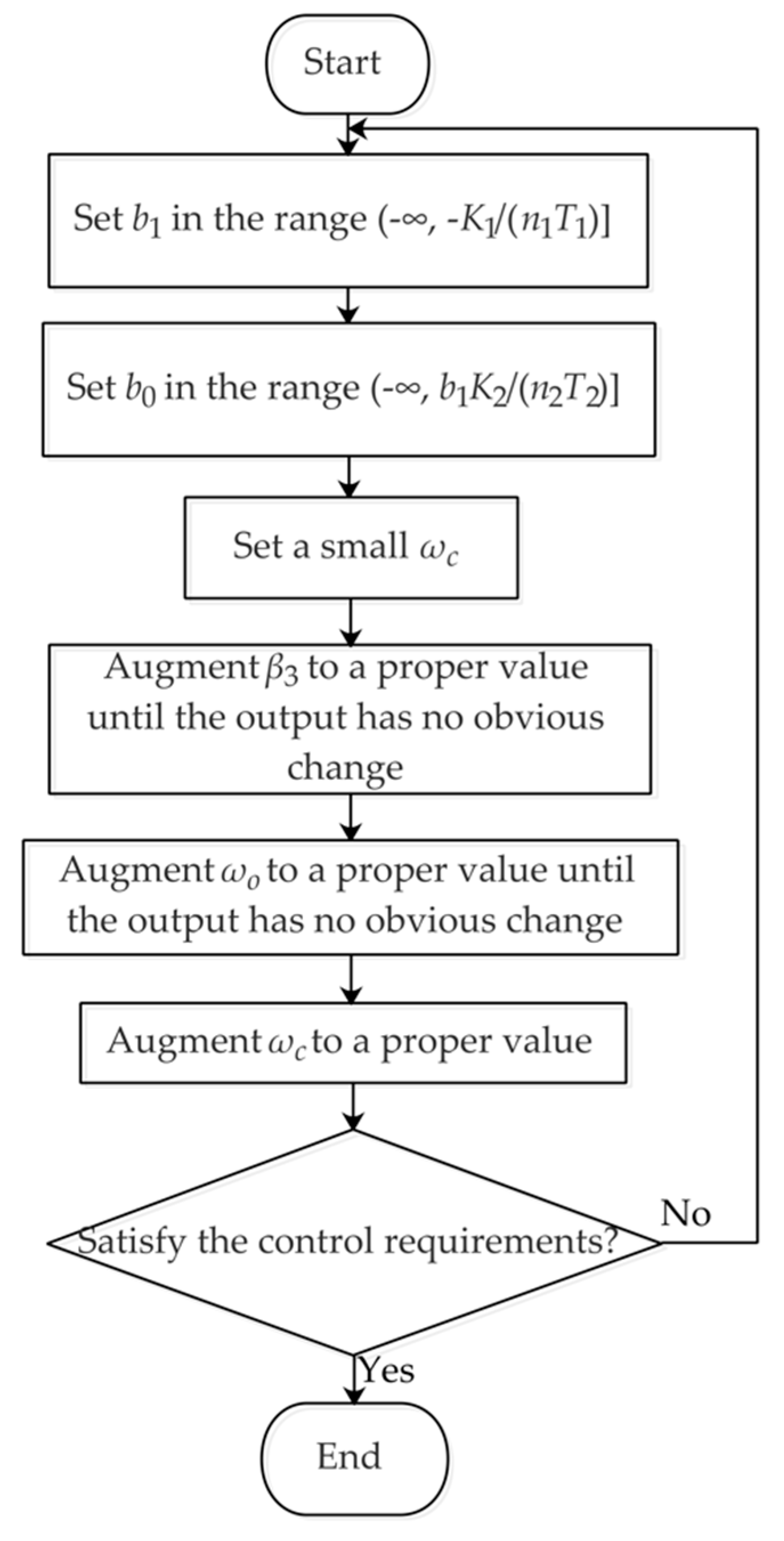

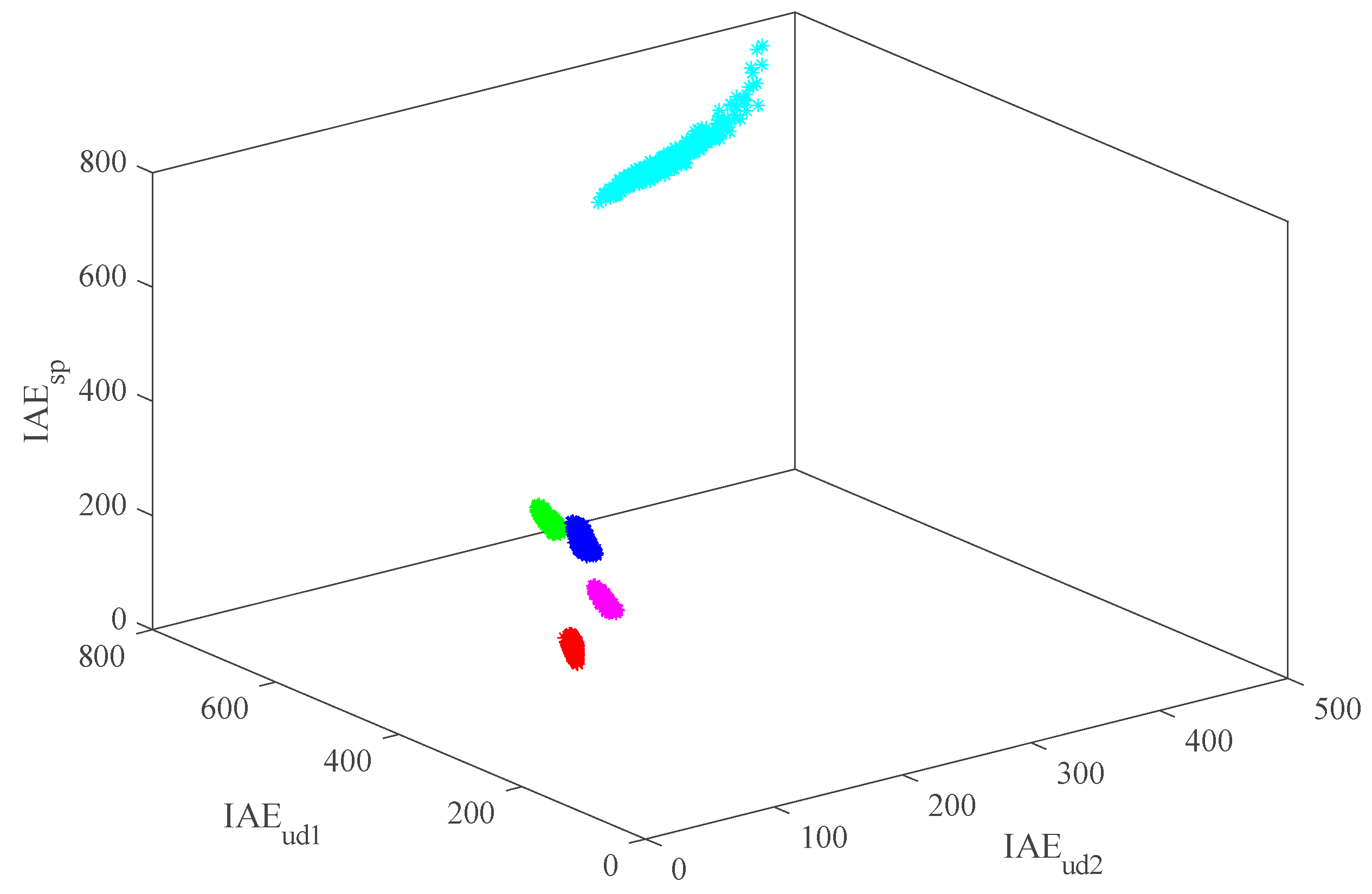
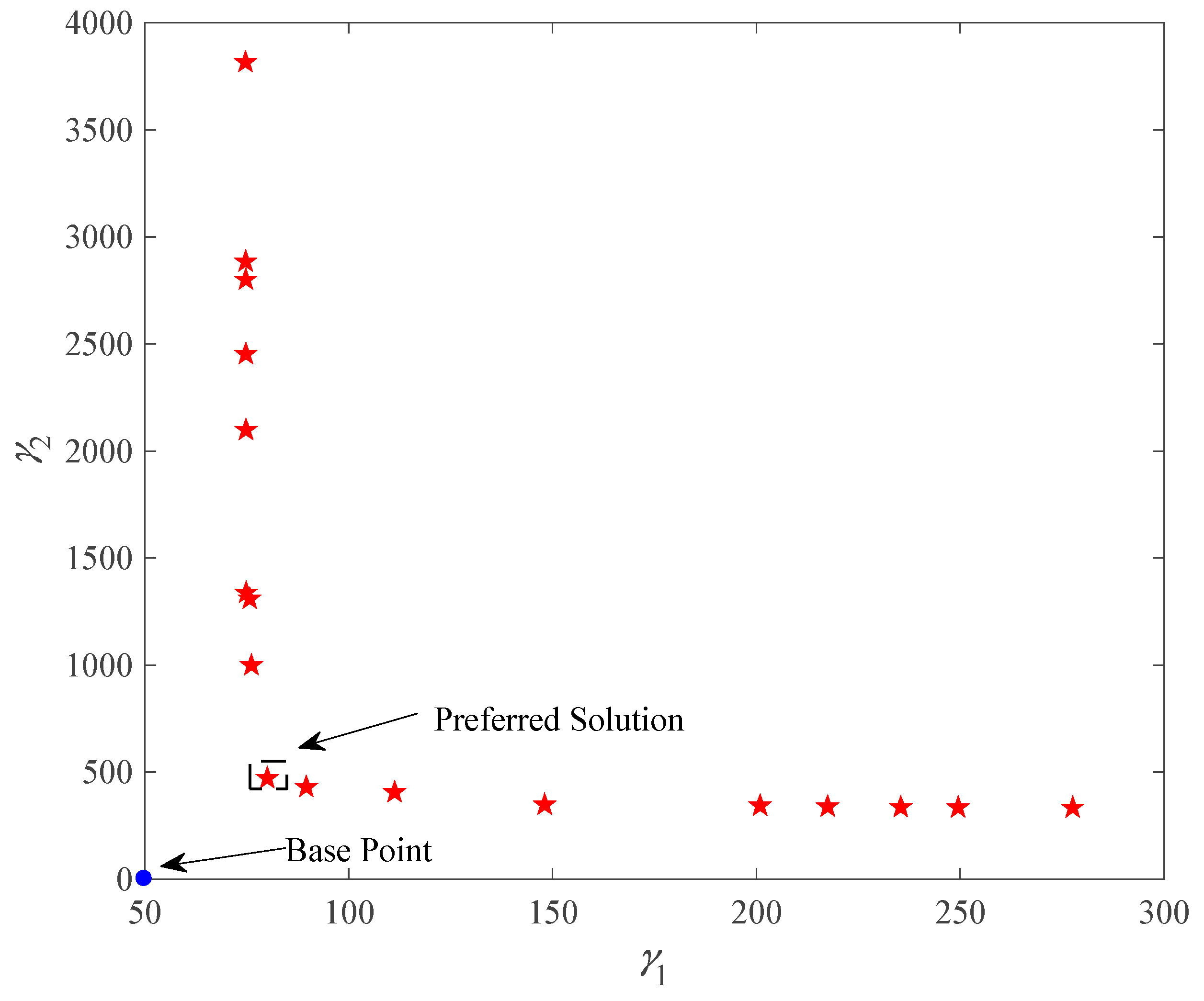
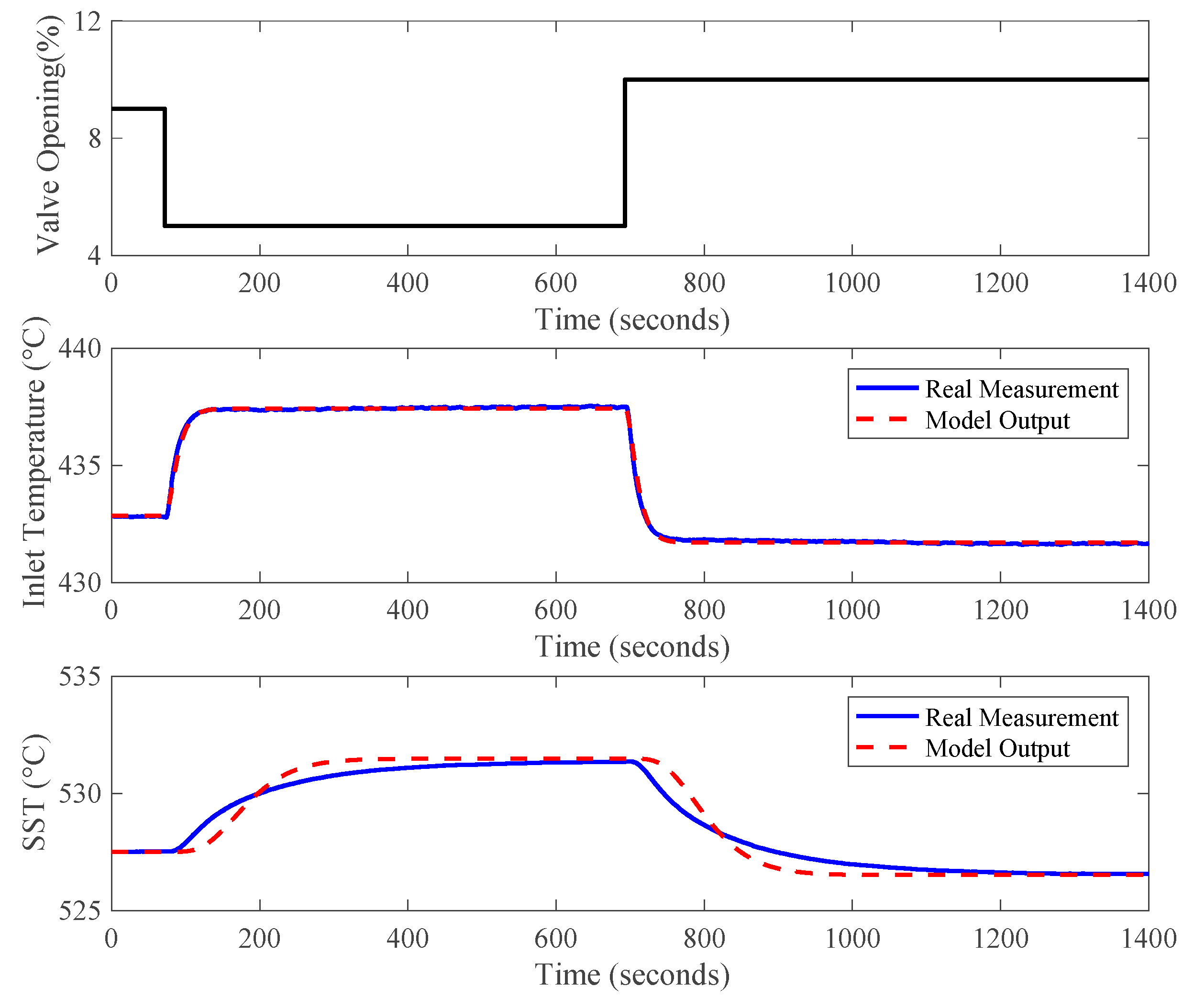
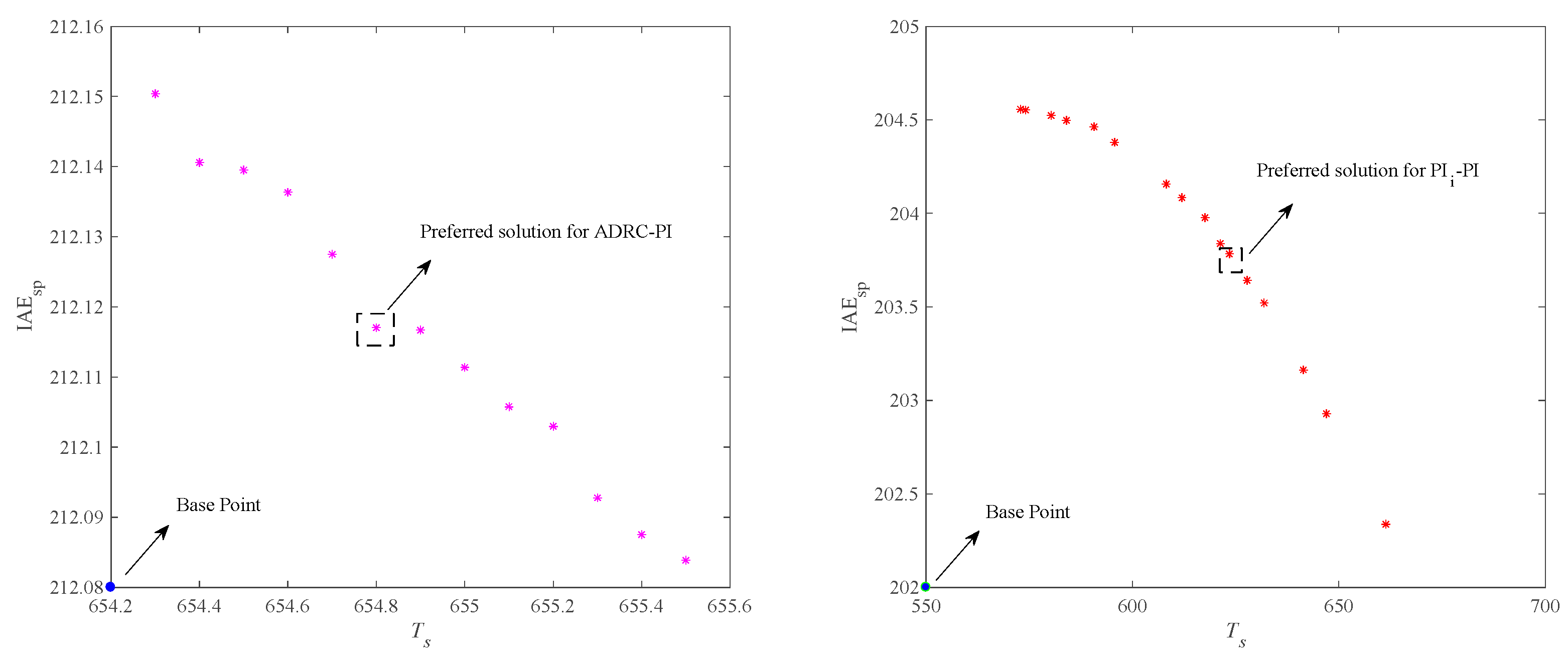
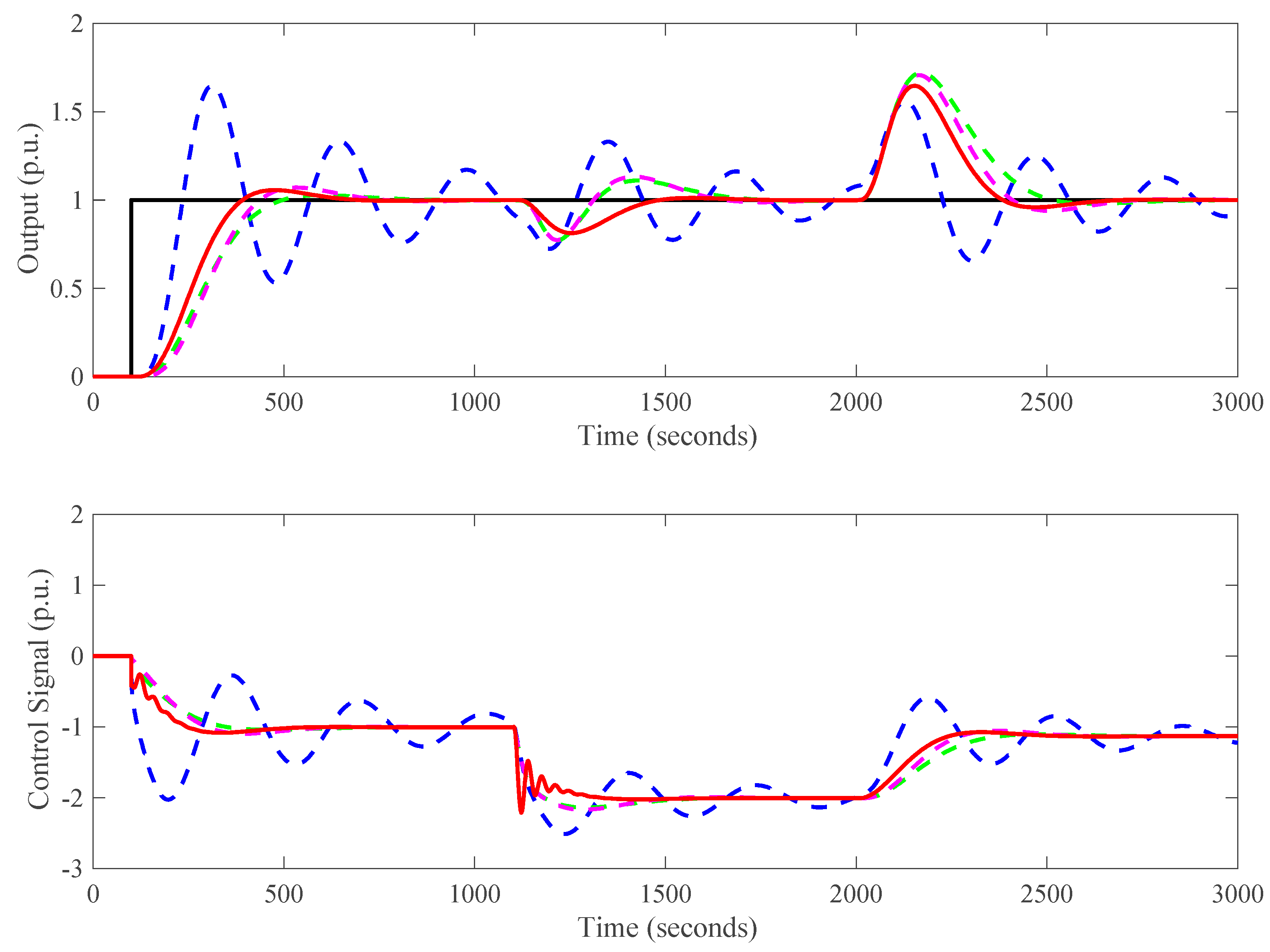
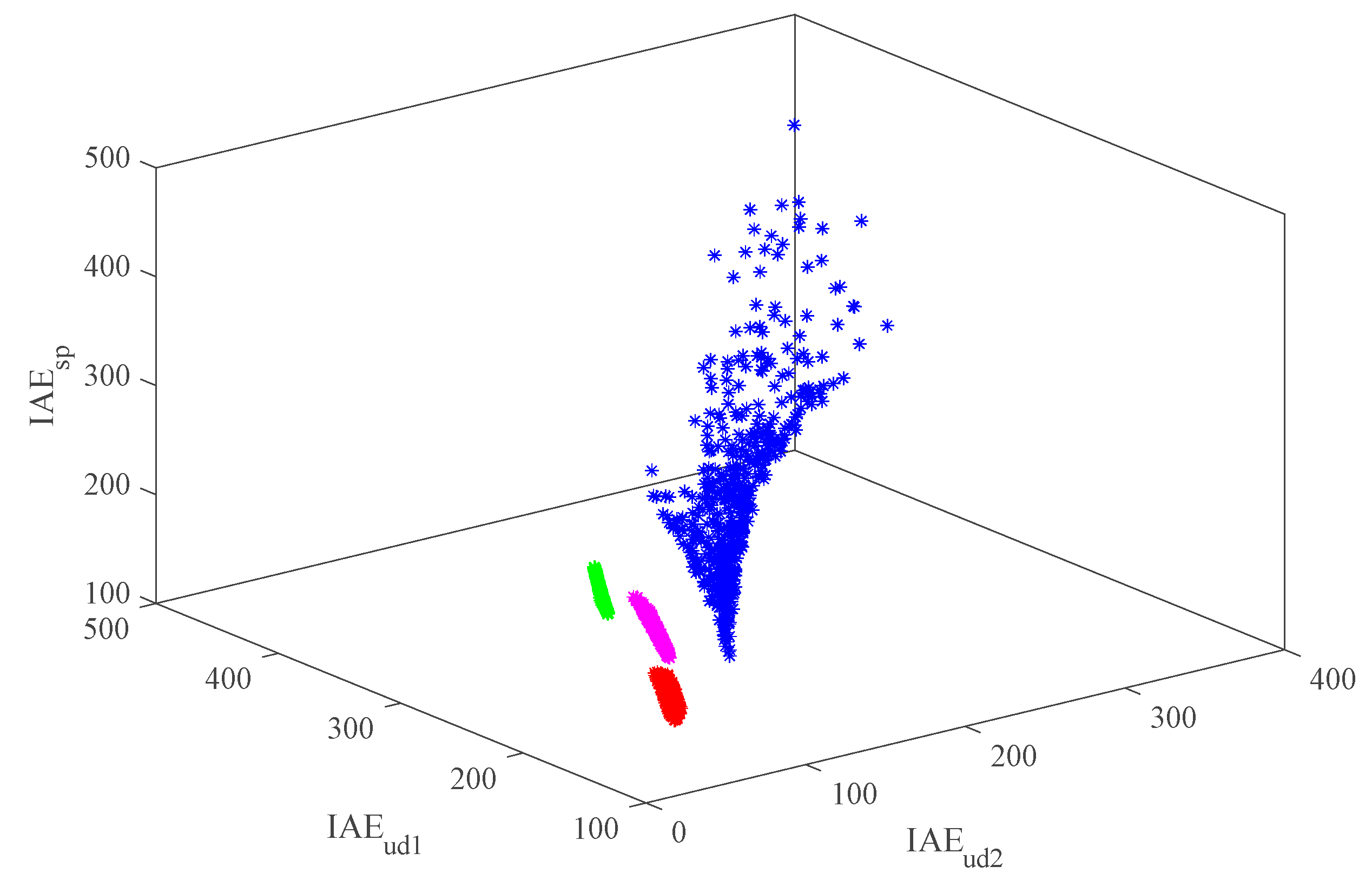

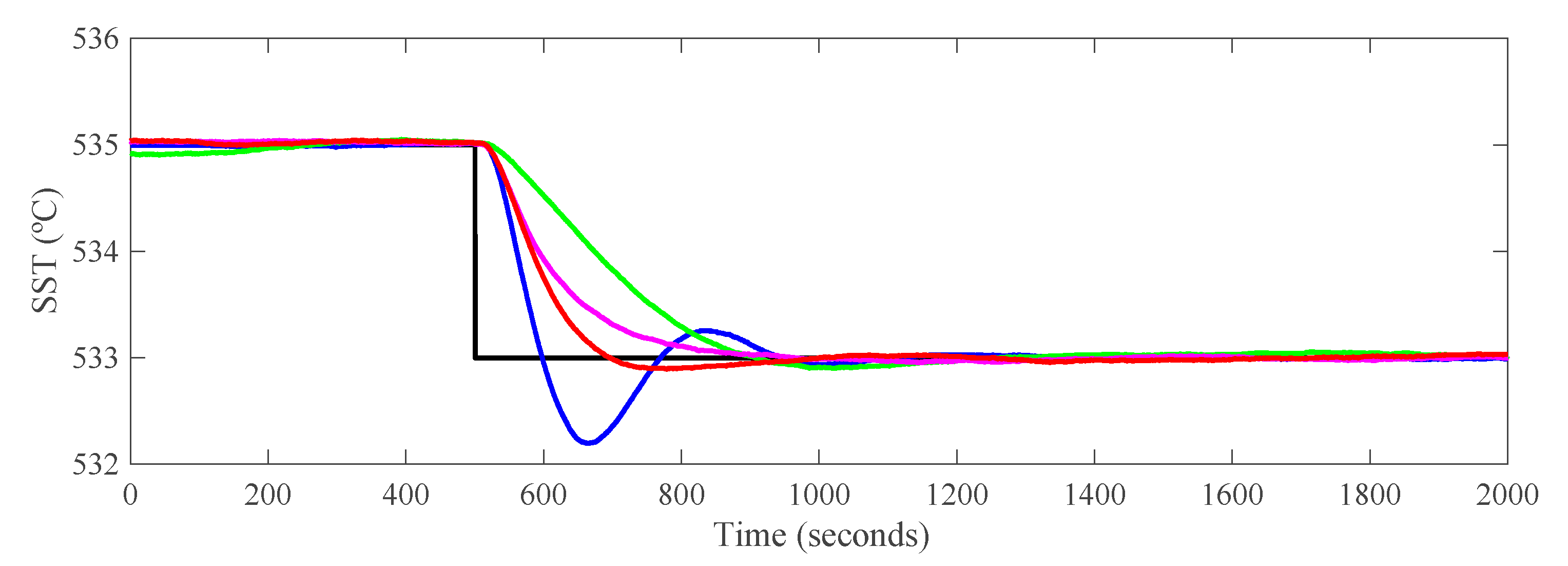

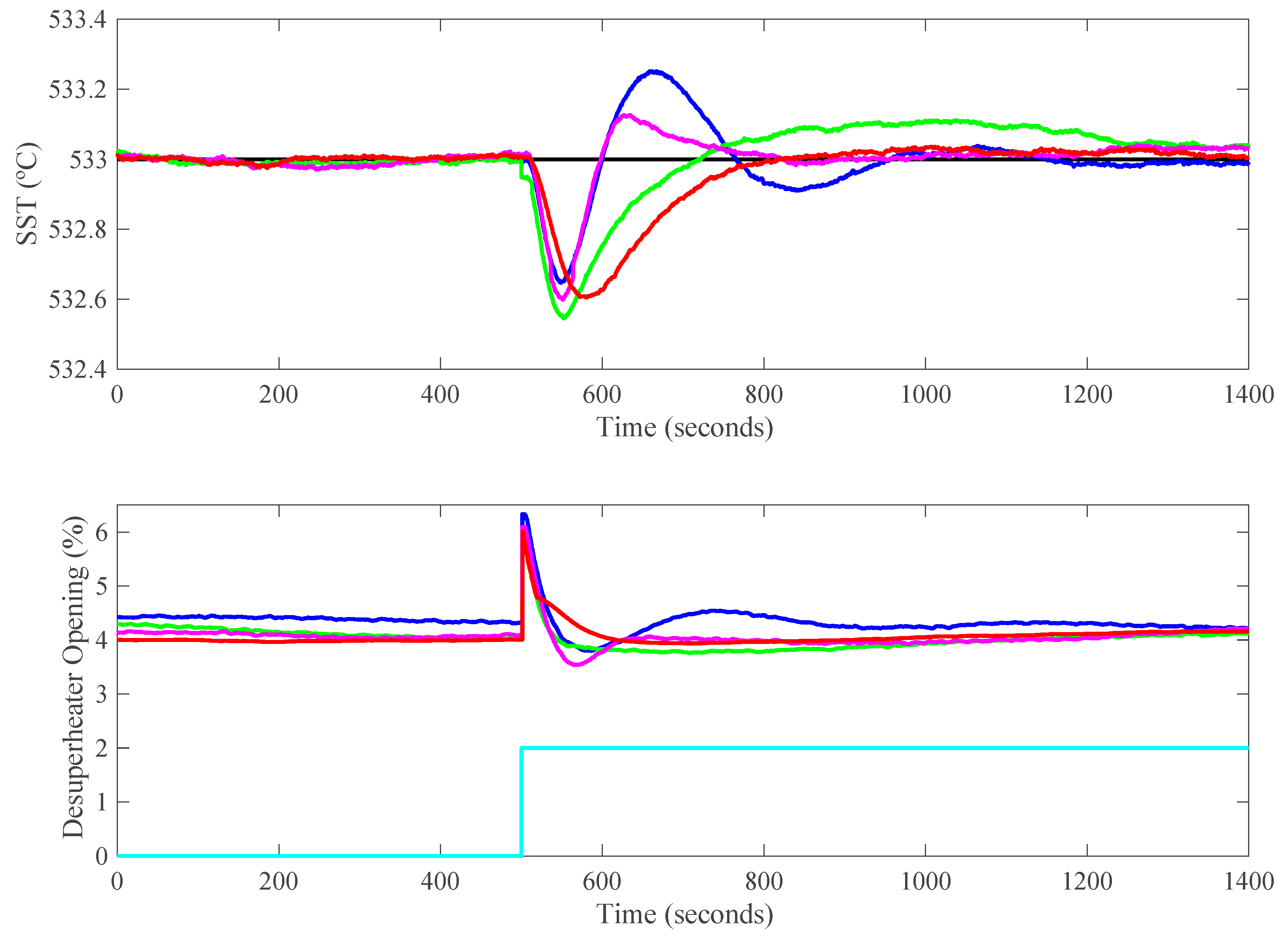
| Control Strategies | Parameters |
|---|---|
| OPI-PI | kp1 = −1/50, ki1 = −1/200, kp2 = 2, ki2 = 1/1000 |
| IPI-PI | kp1 = −1.3, ki1 = −1/70, kp2 = 0.35, ki2 = 1/350 |
| ADRC-PI | kp1 = −1.3, ki1 = −1/70, ωc = 0.032, b0 = 0.01, ωo = 0.15 |
| MADRC-PI | kp1 = −1.3, ki1 = −1/70, ωc = 0.065, =0.01, ωo = 0.5, Gcp(s) = 1/(45s + 1)2 |
| Hybrid ADRC | ωc = 0.05, b0 = −0.18, ωo = 0.2, b1 = −0.026, β3 = 4 |
| Control Strategies | σ (%) | Ts (s) | IAEsp | IAEud2 | IAEud1 |
|---|---|---|---|---|---|
| OPI-PI | 13.5 | 3000 | 692.5 | 323.1 | 658.0 |
| IPI-PI | 0 | 1122.1 | 336.5 | 92.4 | 349.9 |
| ADRC-PI | 1.3 | 699.7 | 344.2 | 92.1 | 292.9 |
| MADRC-PI | 1.0 | 578.3 | 260.5 | 82.7 | 238.8 |
| Hybrid ADRC | 0.2 | 423.8 | 215.1 | 41.6 | 202.9 |
| Control Strategies | IAEsp | IAEud2 | IAEud1 |
|---|---|---|---|
| OPI-PI | [652.41, 743.52] | [280.88, 465.72] | [605.01, 780.49] |
| IPI-PI | [306.29, 373.81] | [82.42, 102.51] | [349.97, 350.00] |
| ADRC-PI | [315.40, 374.46] | [82.15, 102.66] | [282.71, 315.20] |
| MADRC-PI | [236.25, 287.12] | [74.03, 91.51] | [231.74, 255.93] |
| Hybrid ADRC | [193.08, 241.03] | [41.40, 45.51] | [196.40, 226.72] |
| Control Strategies | Parameters |
|---|---|
| PIsim-PI | kp1 = −0.4, ki1 =−0.0286, kp2= 1.2, ki2 = 0.02 |
| PIi-PI | kp1 =−0.4, ki1 = −0.0286, kp2 = 0.24, ki2 = 0.006 |
| ADRC-PI | kp1 = –0.4, ki1 = −0.0286, ωc = 0.033, b0 = 0.28, ωo = 0.14 |
| Hybrid ADRC | ωc = 0.05, b0 =−0.12, ωo = 0.2, b1 = −0.062 β3 = 4 |
| Control Strategies | IAEsp | IAEud2 | IAEud1 |
|---|---|---|---|
| PIsim-PI | 294.9 | 121.6 | 175.0 |
| PIi-PI | 203.7 | 49.5 | 175.3 |
| ADRC-PI | 212.1 | 50.9 | 157.8 |
| Hybrid ADRC | 170.2 | 31.9 | 127.2 |
| Control Strategies | IAEsp | IAEud2 | IAEud1 |
|---|---|---|---|
| PIsim-PI | [208.86, 447.51] | [68.18, 303.70] | [121.65, 395.38] |
| PIi-PI | [182.06, 226.24] | [44.13, 56.29] | [166.82, 196.46] |
| ADRC-PI | [189.53, 234.22] | [44.45, 58.78] | [140.80, 186.42] |
| Hybrid ADRC | [150.59, 189.29] | [28.80, 36.83] | [114.34, 146.51] |
| Cases | Identification Results |
|---|---|
| Case 1 | G1(s) = −1.1460/(9.3277s + 1)2, G2(s) = 0.8395/(25.2207s + 1)4 |
| Case 2 | G1(s) = −1.1419/(9.3228s + 1)2, G2(s) = 0.8511/(24.5357s + 1)4 |
| Case 3 | G1(s) = −1.1375/(9.5711s + 1)2, G2(s) = 0.8253/(23.4598s + 1)4 |
| Case 4 | G1(s) = −1.1403/(9.5427s + 1)2, G2(s) = 0.8650/(25.3223s + 1)4 |
| Case 5 | G1(s) = −1.1316/(9.0642s + 1)2, G2(s) = 0.8357/(25.2794s + 1)4 |
| Case 6 | G1(s) = −1.0191/(9.3027s + 1)2, G2(s) = 0.8819/(26.1402s + 1)4 |
| Control Strategies | IAEsp | IAEud | e+ (°C) | e− (°C) | |
|---|---|---|---|---|---|
| PIsim-PI | 251.3 | 67.5 | 0.252 | 0.353 | 0.068 |
| PIi-PI | 408.2 | 90.9 | 0.111 | 0.455 | 0.101 |
| ADRC-PI | 254.8 | 56.8 | 0.126 | 0.401 | 0.045 |
| Hybrid ADRC | 215.4 | 62.5 | 0.036 | 0.395 | 0.017 |
© 2020 by the authors. Licensee MDPI, Basel, Switzerland. This article is an open access article distributed under the terms and conditions of the Creative Commons Attribution (CC BY) license (http://creativecommons.org/licenses/by/4.0/).
Share and Cite
Shi, G.; Wu, Z.; Guo, J.; Li, D.; Ding, Y. Superheated Steam Temperature Control Based on a Hybrid Active Disturbance Rejection Control. Energies 2020, 13, 1757. https://doi.org/10.3390/en13071757
Shi G, Wu Z, Guo J, Li D, Ding Y. Superheated Steam Temperature Control Based on a Hybrid Active Disturbance Rejection Control. Energies. 2020; 13(7):1757. https://doi.org/10.3390/en13071757
Chicago/Turabian StyleShi, Gengjin, Zhenlong Wu, Jian Guo, Donghai Li, and Yanjun Ding. 2020. "Superheated Steam Temperature Control Based on a Hybrid Active Disturbance Rejection Control" Energies 13, no. 7: 1757. https://doi.org/10.3390/en13071757
APA StyleShi, G., Wu, Z., Guo, J., Li, D., & Ding, Y. (2020). Superheated Steam Temperature Control Based on a Hybrid Active Disturbance Rejection Control. Energies, 13(7), 1757. https://doi.org/10.3390/en13071757






